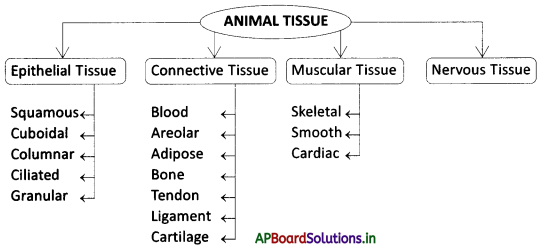Students can go through AP State Board 9th Class Biology Notes Chapter 3 Animal Tissues to understand and remember the concept easily.
AP State Board Syllabus 9th Class Biology Notes Chapter 3 Animal Tissues
→ Tissue is a group of cells similar in structure and functions.
→ In animals, 4 types of tissues are there.
They are:
- Epithelial,
- Connective,
- Muscular,
- Nerve.
→Depending on shape and function, epithelial tissue is classified as squamous, cuboidal, columnar, ciliated, and glandular.
→ Epithelial tissues are present in the skin, lining of the mouth, lining of blood vessels, lung alveoli, and kidney tubules.
→ Squamous epithelium found, where transportation of substances selectively occurs through a permeable membrane.
→ Nails, hair, scales of fishes and reptiles, feathers of birds are modified epithelial cells.
→ Connective tissue connects organs and muscles.
→ The different types of connective tissues in our body include areolar tissue, adipose tissue, bone, tendon, ligament, cartilage, and blood
→ The blood consists of plasma, RBC, WBC, and platelets.
→ Osteocytes secrete salts present in the bone marrow.
→ Cartilage is found in the joints of bones, the tip of ribs, the tip of the nose, external ears, and the trachea.
→ Embryos of several vertebrates have only cartilage.
→ Ligaments and tendons are made of collagen.
→ Hemoglobin gives the red color to the blood, present in RBC.
![]()
→ The cockroach has white blood and the snail has blue colored blood
→ Heparin helps to prevent blood clotting in blood vessels.
→ RBC is also called erythrocytes.
→ WBC is also called leucocytes.
→ Dead WBC comes out of the wound as pus.
→ Four types of blood groups are found in human beings by Carl Land Steiner.
→ The different types of connective tissues in our body include areolar tissue, adipose tissue, bone, tendon, ligament, cartilage, and blood.
→ Striated, unstriated, and cardiac are three types of muscle tissues.
→ Nervous tissue is made of neurons that receive and conduct impulses.
→ Tissue: A group of cells similar in structure and function.
→ Epithelial tissue: Tissue present inside or outside of the animal body.
→ Connective tissue: Connects organs and muscles.
→ Insulator: Detachment from other objects, separatec1 isolated
→ Bone marrow: central hollow portion of the bone.
→ Bone: A hard one, made of calcium phosphate and calcium carbonate.
![]()
→ Cartilage: One type of bone, but not hard
→ Muscle tissue: Responsible for movements in the body.
→ Nerve tissue: A specialized tissue that responds to internal and external stimuli.
→ Ranvier nodes: Gas or nodes present at regular intervals on myelin sheath are known as Ranvier nodes.

→ Sometimes a portion of epithelial tissue folds Inward and formed a multi-cellular gland. Hence It Is called the granular epithelium.
→ Bone is made of calcium phosphate and calcium carbonate. These salts are secreted by cells called osteocytes. These cells are present in the central hollow portion of the hone called bone marrow.
→ Marcello Malpighi (1628 – 1694):
- Marcello Malpighi was born at Crevalcuore near Bologno, Italy in 1628. In 1649 he began his professional studies at the University of Bologna and in 1653 graduated in Philosophy and Medicine.
- He is regarded with justification as the founding father of animal histology and a number of histological structures still bear his name: Malpighian capsules in the kidney, the malpighian layer in the skin, malpighian tubules in the excretory system of insects, man, etc